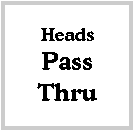 |
. . 12. Pass Thru | |
|---|---|---|
| People Involved | 2 dancers | |
| START | facing dancers | |
| END | back to back | |
| Movement | Dancers move forward, passing right shoulders with each other. Each ends in the other's starting position but neither dancer changes facing direction. | |
| Last Modified, |
[TO JAPANESE VERSION]
HOME - What's New - My Profile - Link Exchange - Guestbook
[Basic] List - 1 - 2 - 3
- 4 - 5
[Mainstream] List - 1 - 2 - 3 [Plus] List - 1 - 2 - 3 - 4
[Advanced-1] List - 1 - 2 - 3 - 4
Sample Sequence - Graphical Image Training
 |
. . 12. Pass Thru | |
|---|---|---|
| People Involved | 2 dancers | |
| START | facing dancers | |
| END | back to back | |
| Movement | Dancers move forward, passing right shoulders with each other. Each ends in the other's starting position but neither dancer changes facing direction. | |
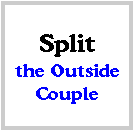 |
. . 13. Split the Outside | |
|---|---|---|
| People Involved | 4 dancers | |
| START | facing couple | |
| END | back to back couple | |
| Movement | he active or directed couple moves forward between the outside couple who sidesteps slightly to let them through then sidesteps back together again. | |
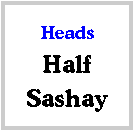 |
. . 14. Half Sashay | |
|---|---|---|
| People Involved | 2 dancers | |
| START | couple | |
| END | couple | |
| Movement | (a) HALF SASHAY: Partners exchange places without changing facing directions. Dancer on the right sidesteps to the left, while the other dancer on the left steps back, sidesteps to the right, then steps forward to rejoin partner. (b) ROLLAWAY: The directed dancer, or if not specified the dancer on the right, rolls across a full turn (360¡) in front of the dancer on the left, as he sidesteps to the right -to exchange places. From a circle, unless otherwise directed, the ladies roll left across in front of the men. (c) LADIES IN, MEN SASHAY: Starting formation -circle or line with alternating men and ladies. With all dancers facing in, the ladies step forward and pause, while the men move to the left behind and past one lady. Ladies step back and rejoin hands with the men. If the circle is moving to the right, the men sashay to the right. |
|
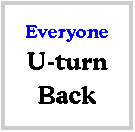 |
. . 15.Turn Back Family | |
|---|---|---|
| People Involved | single dancer | |
| START | anywhere | |
| END | same but looking opposite direction | |
| Movement | (a) U TURN BACK: The dancer does an in-place about-face turn (180¡), turning toward partner unless the body flow dictates otherwise. If alone (i.e. no partner), the dancer turns toward the center of the set. If the dancer is facing directly toward or away from the center of the set, he may turn in either direction. (b) GENTS OR LADIES BACKTRACK: The dancer does a U turn back by stepping out and turning away from partner or the center of the set. |
|
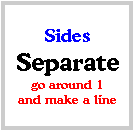 |
. . 16.Separate | |
|---|---|---|
| People Involved | 2 dancers | |
| START | couple | |
| END | depends on the call | |
| Movement | The dancers in the couple turn back to back with each other and walk forward around the outside of the square. The distance traveled is determined by the next call. | |
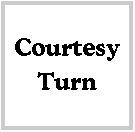 |
. . 17. Courtesy Turn | |
|---|---|---|
| People Involved | 2 dancers | |
| START | couple, facing dancers. (Limited at Mainstream to couples with man on left, woman on right.) | |
| END | same but facing opposit direction | |
| Movement | The man (left hand dancer) takes the lady's (right hand dancer) left hand (palm down) in his left (palm up) and places his right hand in the small of the lady's back. Working as a unit, the couple turns around with the left hand dancer backing up and right hand dancer walking forward. Unless otherwise specified, the couple faces the center of the set or the center of the formation in which it is working. | |
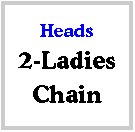 |
. . 18. Ladies Chain Family | |
|---|---|---|
| People Involved | 4 or 8 dancers | |
| START | Ladies Chain: facing couple
Couple Chain Down the Line: RH-2-Faced Line, LH-Wave |
|
| END | facing couple | |
| Movement | (a) TWO LADIES CHAIN: The ladies step forward, extend right
hands to each other and pull by. Each man steps forward and to the right,
turning left to face the same direction as the lady beside him. The lady
extends a left hand to the man for a courtesy turn. Couples end facing each
other. (b) FOUR LADIES CHAIN: Starting formation -square or circle of 8 dancers. Similar to two ladies chain except that all four ladies step to the center and form a right hand star. They turn the star halfway around to their opposite men. All courtesy turn to face the center of the set. NOTE: TWO (or FOUR) LADIES CHAIN THREE QUARTERS: Starting formation -facing couples, a square or circle of 8 dancers. The directed ladies step to the center, form a right hand star and turn the star three quarters. All courtesy turn to face the center of the set. (c) CHAIN DOWN THE LINE: From a right hand line or left hand ocean wave, centers trade while ends adjust as necessary. Then the ends courtesy turn the centers. Ending formation is facing couples. |
|
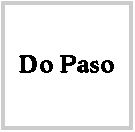 |
. . 19. Do Paso | |
|---|---|---|
| People Involved | 4 or 8 dancers | |
| START | square or circle | |
| END | square or circle | |
| Movement | Each dancer faces partner or directed dancer and does a left arm turn half (180¡) to face in the opposite direction. Releasing armholds and moving forward, each dancer goes to the corner for a right arm turn half (180¡). Each returns to the starting partner to courtesy turn to face the center of the set or to follow the next call. | |
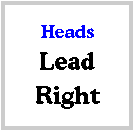 |
. . 20. Lead Right | |
|---|---|---|
| People Involved | 2 dancers | |
| START | couple | |
| END | couple | |
| Movement | Directed couple(s) take a step forward, and as a unit turn to the right 90¡ and move forward. | |
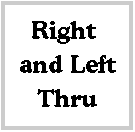 |
. . 21. Right and Left Thru | |
|---|---|---|
| People Involved | 4 dancers | |
| START | facing couple | |
| END | facing couple | |
| Movement | Dancers step forward, join right hands with the dancer directly ahead and pull by. Each couple then does a courtesy turn to face the other couple. | |
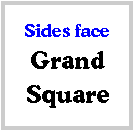 |
. . 22. Grand Square | |
|---|---|---|
| People Involved | 8 dancers | |
| START | square | |
| END | square | |
| Movement | A call that has the sides doing one part while at the same time the heads are doing another. Heads move forward into the square (4 steps), turning one quarter (90¡) on the fourth step to face partners and back away to the sides of the square (4 steps). Turn one quarter (90¡) to face the original opposites. Back away to the corners of the square (4 steps) and turn one quarter (90¡) to face original partners and walk forward to home (4 steps). Do not turn. (Total to here: 16 steps.) From this point the action is reversed. Heads back away from their partners (4 steps), turning one quarter (90¡) on the fourth step and walk forward to the opposites (4 steps). Turn one quarter and walk forward into the center toward partners (4 steps). Turn one quarter (90¡) to face opposites and back up to home (total: 32 steps). While the head couples are doing the first 16 steps, the sides start by facing their partners to back away and do the second 16 steps. Completing this, the sides do the first 16 steps, while the heads are doing the last 16. The principle of walking three steps and then turning (or reversing) on the fourth step is followed throughout. This call may be broken into fractional parts by the caller directing the number of steps required. The call may also start with the heads, or other designated dancers, directed to face. | |
[ List ] Basic - Mainstream - Plus - Advanced-1
SAMPLE
SEQUENCE - Graphical Image Training
TOP Page